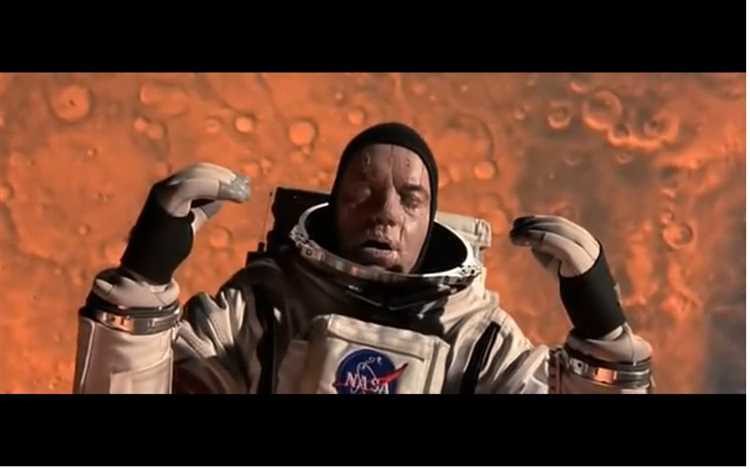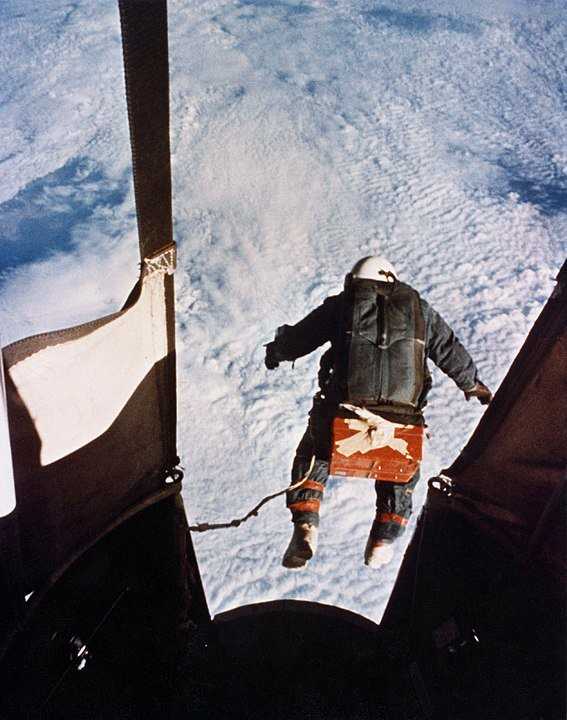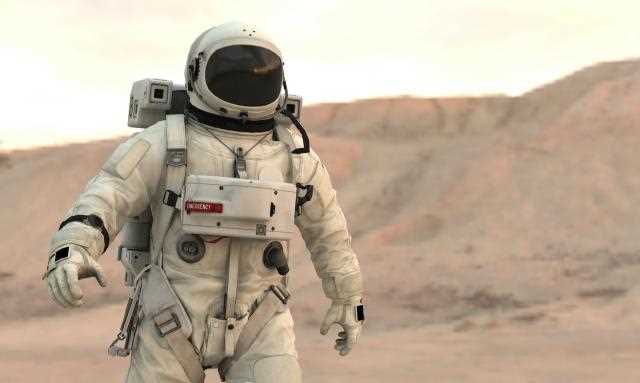
Mars, the fourth planet from the Sun, has always been a topic of fascination for astronomers and scientists. With its similarities to Earth and the potential for supporting life, it has become a prime target for future manned missions. However, the harsh conditions on Mars pose a great challenge for human exploration.
One of the most critical aspects of exploring Mars is the need for a suitable environment for humans to survive. The thin atmosphere and extreme temperatures on Mars make it impossible for humans to live on its surface without adequate protection. This is why astronauts wear spacesuits and helmets when venturing outside their habitats.
But what would happen if an astronaut were to remove their helmet on Mars? The consequences would be dire. The thin atmosphere, consisting mainly of carbon dioxide, would prevent the astronaut from breathing. Without the pressure and oxygen of Earth’s atmosphere, the lungs would fail to function properly, leading to a rapid loss of consciousness and eventually death.
Furthermore, Mars’ low temperature would quickly cause the body to lose heat. The average surface temperature on Mars is around -80 degrees Fahrenheit (-62 degrees Celsius). Without the protection provided by the spacesuit, the body would rapidly succumb to freezing temperatures, leading to hypothermia.
In addition to the lack of breathable air and extreme temperature, Mars’ atmosphere also offers little protection from harmful radiation. The planet does not have a strong magnetic field or a thick atmosphere to shield against solar radiation and cosmic rays. Without the protection of a spacesuit, an astronaut would be exposed to dangerous levels of radiation, causing long-term health issues and potentially increasing the risk of developing cancer.
Therefore, it is absolutely crucial for astronauts to keep their helmets on at all times while on the Martian surface. The spacesuit acts as a lifeline, providing breathable air, temperature regulation, and protection from radiation. Removing the helmet on Mars would be a fatal mistake, highlighting the harsh reality of exploring the Red Planet.
- The Consequences of Removing Your Helmet on Mars
- The Importance of Proper Equipment and Safety Protocols
- Conclusion
- Lack of Oxygen
- Effects of Oxygen Deprivation
- The Importance of Life Support Systems
- Extreme Cold Temperatures
- The Dangers of Hypothermia
- Protective Measures
- High Levels of Radiation
- The Effects of Radiation Exposure
- Protective Measures on Mars
- Thin Atmosphere
- Effects on Human Exploration
- Potential Solutions
- Risk of Dust Storms
- Precautions
- Emergency Procedures
- Absence of Liquid Water
- Question-answer:
- What is the purpose of wearing a helmet on Mars?
- What would happen if an astronaut removes their helmet on Mars?
- How long can an astronaut survive on Mars without a helmet?
- Is it ever safe to remove a helmet on Mars?
- What precautions do astronauts take before removing their helmets on Mars?
- Why would someone want to remove their helmet on Mars?
The Consequences of Removing Your Helmet on Mars
Exploring Mars, the red planet, is an exciting endeavor for humans. The planet possesses a thin atmosphere that is primarily composed of carbon dioxide. However, it lacks the necessary amount of oxygen to sustain human life. Therefore, wearing a space suit with a helmet is absolutely essential for any astronaut venturing onto the Martian surface.
If an astronaut was to remove their helmet on Mars, the consequences would be dire. Firstly, the astronaut would experience rapid decompression as the pressure outside the suit is much lower than inside. This would cause all the fluids in the body to boil at an accelerated rate, leading to severe injuries and potential fatality.
Aside from the immediate decompression effects, the lack of oxygen would result in asphyxiation. The human body requires a constant supply of oxygen to maintain vital bodily functions. Without it, the brain would quickly suffer from oxygen deprivation, leading to unconsciousness and eventual death.
In addition to the physical dangers, the Martian environment also poses a threat in terms of temperature. Mars has an average surface temperature of about -80 degrees Fahrenheit (-62 degrees Celsius). Removing the helmet would expose the astronaut to extreme cold, which can lead to frostbite and hypothermia.
Furthermore, Mars is known for its fine dust particles that permeate the atmosphere. These particles are composed of iron oxide and can be harmful if inhaled. Without a helmet, an astronaut would be at risk of inhaling these particles, which could irritate the respiratory system and potentially cause long-term health issues.
The Importance of Proper Equipment and Safety Protocols

Given the harsh conditions on Mars, it is crucial for astronauts to follow strict safety protocols and use appropriate equipment. A space suit with a helmet provides a protective barrier that maintains a breathable atmosphere and shields the body from extreme temperatures and harmful particles.
Before any mission to Mars, astronauts undergo extensive training to prepare for the challenges they may face. They learn how to properly operate their suits and follow safety procedures to ensure their own well-being and the success of the mission.
Conclusion
Removing a helmet on Mars is a grave mistake that would have severe consequences. From decompression and asphyxiation to exposure to extreme cold and harmful particles, the risks are life-threatening. It is crucial for astronauts to understand the importance of their equipment and safety protocols to ensure their safety and the success of the mission to explore the mysteries of Mars.
Lack of Oxygen
One of the major challenges humans would face if they were to remove their helmet on Mars is the lack of oxygen. Unlike Earth, Mars has an extremely thin atmosphere consisting primarily of carbon dioxide. This means that there is not enough oxygen in the Martian atmosphere to support human life.
If an astronaut were to remove their helmet on Mars, they would quickly succumb to hypoxia, a condition where the body is starved of oxygen. Without oxygen, the body’s cells would be unable to produce energy, leading to organ failure and ultimately death.
Effects of Oxygen Deprivation
The lack of oxygen has numerous effects on the body. Initially, the individual would experience difficulty breathing as their lungs struggle to extract oxygen from the thin Martian atmosphere. This would quickly lead to dizziness, lightheadedness, and impaired judgment.
As the oxygen deprivation continues, the person would begin to lose consciousness and their brain function would severely degrade. The lack of oxygen would also have a detrimental effect on the cardiovascular system, leading to a decreased heart rate and low blood pressure.
In addition to the immediate physical effects, long-term exposure to the Martian environment without proper life support systems would have a lasting impact on the body. Extended periods of oxygen deprivation can cause permanent damage to the brain and other vital organs.
The Importance of Life Support Systems
Considering the lack of oxygen on Mars, it is crucial for astronauts to rely on advanced life support systems to survive. These systems would need to generate oxygen for breathing, remove carbon dioxide, and regulate temperature and pressure inside the spacesuit or habitat.
The life support systems used on Mars missions would need to be highly efficient and reliable, as any failure could have dire consequences. The success of future human missions to Mars depends on developing and implementing robust life support technologies to ensure the availability of breathable air for astronauts.
| Effects of Lack of Oxygen on Mars | Symptoms |
|---|---|
| Hypoxia | Difficulty breathing, dizziness, impaired judgment |
| Loss of Consciousness | Decreased brain function, disorientation |
| Cardiovascular Effects | Decreased heart rate, low blood pressure |
| Long-Term Damage | Brain and organ damage |
Extreme Cold Temperatures
One of the biggest challenges of removing your helmet on Mars is dealing with the extreme cold temperatures of the planet. Mars is known for its frigid climate, with average temperatures ranging from -80 degrees Fahrenheit (-62 degrees Celsius) to -195 degrees Fahrenheit (-126 degrees Celsius). These temperatures are significantly colder than anything experienced on Earth.
Exposing your body to such extreme cold can have serious consequences. Without proper protection, the cold air would immediately rob your body of heat, leading to rapid hypothermia. Hypothermia occurs when your body loses heat faster than it can produce it, resulting in a dangerously low body temperature.
The Dangers of Hypothermia
Hypothermia can cause a range of symptoms, starting with shivering, confusion, and fatigue. As your body temperature continues to drop, you may experience loss of coordination, slurred speech, and intense shivering. In severe cases, hypothermia can lead to unconsciousness, organ failure, and even death.
In space, the lack of an atmosphere means that there is no natural insulation to protect you from the extreme cold. This means that even a short exposure to the Martian environment without proper protective gear could be incredibly dangerous.
Protective Measures
Before venturing outside, astronauts on Mars would need to ensure they are wearing a pressurized space suit specifically designed to withstand the extreme cold temperatures. These suits provide insulation and heating elements to maintain a safe body temperature.
In addition to wearing a space suit, astronauts would also need to take extra precautions to protect exposed skin, such as their face and hands, from the extreme cold. Specialized gloves and face shields would be necessary to prevent frostbite and other cold-related injuries.
The extreme cold temperatures on Mars are just one of the factors that make removing a helmet inadvisable. The thin atmosphere, lack of oxygen, and extreme levels of radiation are also significant hazards that astronauts must consider and protect against.
Overall, the extreme cold temperatures on Mars make it crucial for astronauts to always prioritize safety and ensure they are properly equipped before undertaking any activities outside of their spacecraft. Without the right protective gear, the consequences could be potentially life-threatening.
High Levels of Radiation
When removing your helmet on Mars, one of the biggest dangers you face is the high levels of radiation present on the planet’s surface. Unlike Earth, Mars lacks a thick atmosphere and a strong magnetic field, which means that the surface is exposed to significantly more radiation from the sun and cosmic rays.
The radiation on Mars primarily consists of two types: solar particle events (SPEs) and galactic cosmic rays (GCRs). Solar particle events occur when eruptions on the sun’s surface release high-energy particles. GCRs, on the other hand, are high-energy radiation that originates from outside our solar system and is constantly bombarding Mars.
The Effects of Radiation Exposure
Exposure to high levels of radiation can have serious implications for human health. On Mars, the lack of protective measures like Earth’s atmosphere and magnetic field means that astronauts are more susceptible to radiation-related health problems.
Some of the potential effects of radiation exposure include an increased risk of cancer, damage to DNA, and radiation sickness. These risks escalate over time as the cumulative exposure to radiation increases. Additionally, astronauts on Mars may experience acute radiation sickness, which can lead to nausea, fatigue, and a weakened immune system.
Protective Measures on Mars
To mitigate the risks associated with radiation exposure, astronauts on Mars will need to take various protective measures. These measures may include wearing radiation shielding, both in their suits and in potential habitats, to reduce the amount of radiation they receive.
Another possibility is to establish underground habitats to provide additional shielding from radiation. The Martian soil and rock can act as a natural barrier against radiation, offering added protection for astronauts during their stay on the planet.
Furthermore, astronauts will need to closely monitor radiation levels and limit their time spent outside of their habitats, especially during times of increased solar activity. Understanding the patterns and levels of radiation on Mars will be essential for ensuring the safety and well-being of future Martian explorers.
In conclusion, the high levels of radiation on Mars pose a significant risk to human health. Protective measures, such as radiation shielding and underground habitats, will be crucial for protecting astronauts and ensuring their safety during missions to the Red Planet.
Thin Atmosphere
Mars has a thin atmosphere compared to Earth. Its atmosphere is composed mostly of carbon dioxide and is about 100 times thinner than Earth’s atmosphere. The low atmospheric pressure on Mars makes it difficult for liquids to exist in their liquid state, as they would quickly evaporate. This means that water on Mars is either frozen or in the form of ice. Additionally, the thin atmosphere means that the temperature on Mars can vary greatly, with extreme cold temperatures during the night and relatively warmer temperatures during the day.
Due to the thin atmosphere, Mars is also more susceptible to solar radiation. The lack of a dense atmosphere to block out harmful radiation means that astronauts would be at a higher risk of exposure to radiation when on the surface of Mars. This is one of the challenges that would need to be addressed when considering human exploration and potential colonization of the planet.
Effects on Human Exploration

The thin atmosphere on Mars poses several challenges for human exploration. One of the most significant challenges is the lack of breathable air. Without the necessary oxygen levels, astronauts would need to rely on artificial life support systems or wear spacesuits that provide a breathable atmosphere. This would add complexity to any human missions to Mars and would require careful planning and preparation.
Another effect of the thin atmosphere is the lack of protection from harmful cosmic rays and solar radiation. These radiation levels could pose a significant risk to astronauts, potentially leading to long-term health issues. Shielding and protective measures would need to be implemented to minimize this risk.
Potential Solutions
To overcome the challenges posed by the thin atmosphere on Mars, scientists and engineers are exploring various potential solutions. One solution is the development of advanced life support systems that can sustain astronauts for extended periods in a low-oxygen environment. These systems would need to efficiently recycle resources and generate oxygen for breathing.
Another solution is the development of advanced radiation shielding technologies. These could include materials that can absorb and block harmful radiation, as well as innovative designs for habitats and vehicles that provide additional protection. Additionally, the placement of habitats and exploration sites in underground or shielded locations could help reduce radiation exposure.
Overall, the thin atmosphere on Mars presents unique challenges for human exploration and requires innovative solutions. Through continued research and technological advancements, scientists and engineers can work towards making Mars a viable destination for human exploration and potential colonization in the future.
Risk of Dust Storms
One of the major risks of removing your helmet on Mars is the potential for dust storms. Mars is known for its frequent and sometimes massive dust storms that can cover the entire planet for weeks or even months. These storms can create dangerous conditions, including low visibility and high amounts of fine dust particles in the air.
Dust storms on Mars can reach speeds of up to 60 miles per hour, posing a significant risk to anyone without proper protection. The fine dust particles can be abrasive and damaging to the skin and eyes, causing irritation and potentially leading to long-term health issues.
In addition to the physical dangers, dust storms can also disrupt communication and navigation systems, making it challenging to coordinate rescue efforts or contact mission control. The thick dust in the air can block signals and degrade equipment, further complicating any emergency situation.
Precautions

To mitigate the risk of dust storms, astronauts on Mars must be equipped with specialized suits and helmets that are designed to withstand the harsh environment. These suits are carefully sealed to prevent dust from entering and have built-in ventilation systems to filter the air.
It is important for astronauts to closely monitor weather conditions and seek shelter in the event of a dust storm. They must also perform regular maintenance on their suits to ensure they remain airtight and functional.
Emergency Procedures
In the case of an unexpected dust storm while outside the habitat, astronauts are trained to quickly return to safety and seek shelter. They are prepared to wait out the storm until conditions improve and it is safe to venture out again.
In extreme cases, if a dust storm persists for an extended period, astronauts may be forced to ration supplies and conserve energy until they can safely resume their activities.
Absence of Liquid Water

One of the most significant factors for the absence of liquid water on Mars is its thin atmosphere. The Martian atmosphere is only about 1% as dense as Earth’s atmosphere, which means that water cannot remain in its liquid state on the surface. Instead, any water present on Mars would either freeze solid or evaporate into the thin atmosphere.
Furthermore, the average temperature on Mars is much colder than on Earth, with average temperatures around -80 degrees Fahrenheit (-62 degrees Celsius). These extreme cold temperatures also prevent liquid water from existing on Mars.
In addition to the thin atmosphere and cold temperatures, Mars’ lack of a global magnetic field allows the solar wind to strip away its atmosphere. Without a protective magnetic field, any liquid water on Mars would be exposed to the harsh solar radiation, causing it to rapidly evaporate.
However, despite the absence of liquid water on the surface, scientists have discovered evidence of past liquid water on Mars. Channels and valleys on the Martian surface indicate that liquid water once flowed, suggesting that Mars may have had a warmer and wetter environment in the past.
Overall, the absence of liquid water on Mars is a result of its thin atmosphere, cold temperatures, lack of a global magnetic field, and exposure to solar radiation. Understanding the conditions that prevent liquid water on Mars is crucial for future exploration and potential colonization efforts on the Red Planet.
Question-answer:
What is the purpose of wearing a helmet on Mars?
The purpose of wearing a helmet on Mars is to protect astronauts from the thin atmosphere, extreme temperatures, and harmful radiation on the planet’s surface.
What would happen if an astronaut removes their helmet on Mars?
If an astronaut removes their helmet on Mars, they would be exposed to the thin atmosphere, which contains very little oxygen, making it impossible to breathe. The low temperatures and lack of pressure would also cause their bodily fluids to boil and ultimately lead to death.
How long can an astronaut survive on Mars without a helmet?
An astronaut would not be able to survive for longer than a few seconds without a helmet on Mars. The lack of oxygen and extreme conditions would quickly lead to asphyxiation and death.
Is it ever safe to remove a helmet on Mars?
No, it is never safe to remove a helmet on Mars. The planet’s thin atmosphere and extreme conditions make it impossible for humans to survive without the necessary protective gear.
What precautions do astronauts take before removing their helmets on Mars?
Astronauts take extensive precautions before removing their helmets on Mars, such as conducting thorough checks of the surrounding environment for any potential hazards, ensuring they are in a controlled and pressurized environment, and having emergency procedures in place in case of any unforeseen circumstances.
Why would someone want to remove their helmet on Mars?
Removing a helmet on Mars is extremely dangerous and can lead to immediate death. There is no breathable atmosphere on Mars, and the lack of oxygen would cause a person to suffocate within seconds.